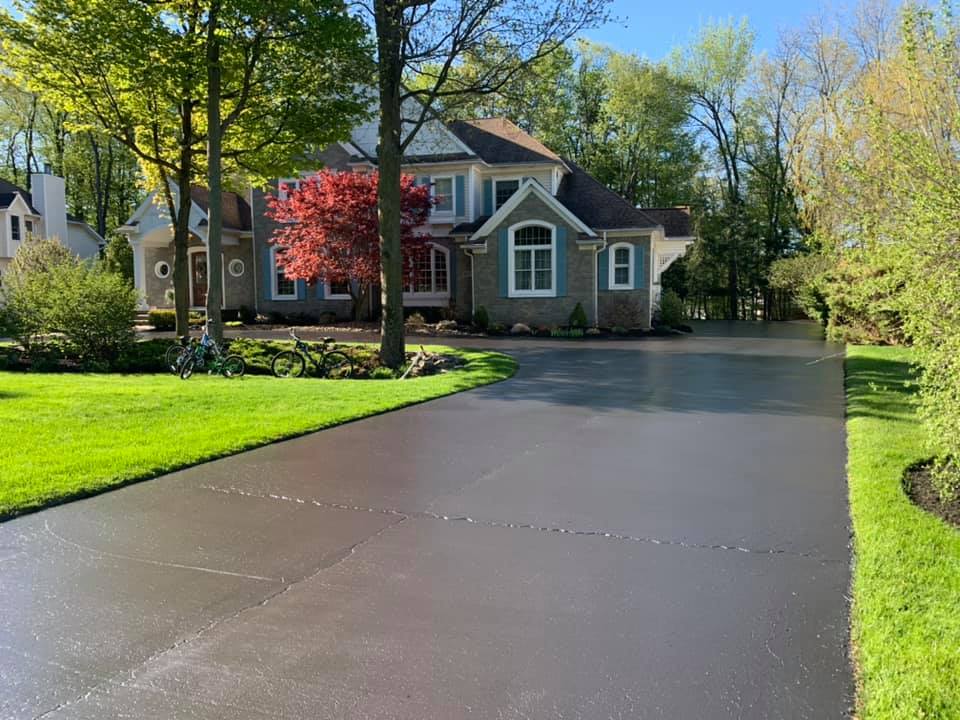Maximize Safety with Angle Parking Areas: Superior Asphalt Sealing
Maximize Safety with Angle Parking Areas: Superior Asphalt Sealing
Blog Article
Cold Mix Asphalt Vs. Hot Mix Asphalt: Which Is Right for You?

Composition Differences
Cold mix and warm mix asphalts vary dramatically in their make-up, with unique features that impact their performance and applications. Cold mix asphalt is produced by emulsifying the asphalt binder with water and an emulsifying representative prior to blending it with aggregate. This technique enables the asphalt to be practical at reduced temperatures, making it excellent for short-lived fixings and for use in colder weather. Hot mix asphalt, on the various other hand, is made at heats, usually between 300-350 ° F, which assists to attain far better compaction and a more resilient end product. The hot mix asphalt production process involves warming the accumulation and asphalt binder independently prior to incorporating them at the asphalt plant.
Furthermore, cold mix asphalt often tends to be much less thick and extra adaptable than warm mix asphalt. This adaptability makes it better suited for areas with higher levels of motion, such as driveways or roadways with rush hour. On the other hand, hot mix asphalt is known for its high longevity and resistance to rutting and fracturing, making it a recommended option for highways and high-traffic roads where longevity is critical.
Installment Refine Variations
The process of installing cold mix and hot mix asphalt displays noteworthy variances in their treatments and needs. Cold mix asphalt, being a much more flexible product, can be used directly from the bag or container onto the fracture or harmed location. It needs marginal preparation work, such as cleaning the location and compacting the cold blend with hand devices. This makes it a convenient alternative for temporary and fast repairs. In comparison, warm mix asphalt requires an extra sophisticated installation procedure. It entails heating up the mixture to high temperature levels prior to laying it down on an effectively ready base. The preparation includes condensing the base, using a tack coat, and making use of heavy equipment like pavers and compactors for a long lasting and smooth finish. As a result of the home heating requirements, warm mix asphalt installations are typically accomplished by specialists with customized devices, ensuring a much more structurally audio and permanent outcome.
Resilience and Durability Aspects
When considering asphalt options, resilience and long life are essential elements to assess for long lasting pavement performance,. Hot mix asphalt (HMA) is understood for its outstanding toughness and long life. The high temperatures throughout the blending and laying process enable much better compaction, causing a denser and more powerful pavement framework. This leads to HMA being more resistant to heavy web traffic loads, extreme weather, and the effects old compared to chilly mix asphalt (CMA)
In regards to durability, HMA generally outmatches CMA due to its Resources premium stamina and resistance buildings. HMA sidewalks have a longer life span, requiring much less frequent fixings and maintenance, which can translate to set you back financial savings over time. Additionally, HMA pavements are extra quickly personalized to satisfy certain project needs, even more boosting their sturdiness.
Price Factors To Consider
Thinking about the economic implications is a crucial element when examining the option in between hot mix asphalt (HMA) and cold mix asphalt (CMA) for pavement tasks. While the preliminary expense of hot mix asphalt is generally higher than that of cold mix asphalt, HMA frequently supplies an extra cost-efficient remedy in the lengthy run due to its remarkable resilience and durability.
In addition to material prices, it's essential to take into consideration the expenses related to installment and maintenance when comparing HMA and CMA. HMA typically calls for specialized equipment and skilled labor for correct installment, which can influence general project prices. On the other hand, CMA is less complicated to deal with and can frequently be used utilizing simpler techniques, possibly lowering installment costs. Eventually, the decision between HMA and CMA must consider not just the initial cost however also the lasting financial implications to figure out the most cost-effective alternative for the specific sidewalk job.
Environmental Effect Contrast
Comparison of the environmental effects in between warm hop over to here mix asphalt (HMA) and cold mix asphalt (CMA) exposes unique differences in sustainability methods. HMA production calls for high temperature levels, leading to increased power intake and greenhouse gas emissions.
Additionally, the use of CMA usually includes reusing existing asphalt pavement, promoting source conservation and reducing the amount of waste sent to landfills. By deciding for CMA over HMA, road construction tasks can add positively to ecological conservation efforts.
Conclusion
Finally, the choice between cool mix asphalt (CMA) and hot mix asphalt (HMA) depends upon various factors such as make-up, installation process, durability, durability, cost, and ecological influence. angle parking. While CMA supplies a quick and cost-effective service for minor fixings, HMA makes certain exceptional sturdiness and durability for rush hour locations. Think about these aspects carefully to identify which type of asphalt is the best selection for your paving requires

Thinking about the financial effects is a critical aspect websites when assessing the selection between warm mix asphalt (HMA) and cold mix asphalt (CMA) for sidewalk tasks. While the initial expense of warm mix asphalt is typically greater than that of cool mix asphalt, HMA often offers an extra cost-effective remedy in the long run due to its exceptional resilience and longevity. asphalt repair.Comparison of the ecological impacts between warm mix asphalt (HMA) and cold mix asphalt (CMA) exposes unique distinctions in sustainability techniques.In verdict, the selection between chilly mix asphalt (CMA) and hot mix asphalt (HMA) depends on different variables such as make-up, installment procedure, sturdiness, long life, price, and ecological effect
Report this page